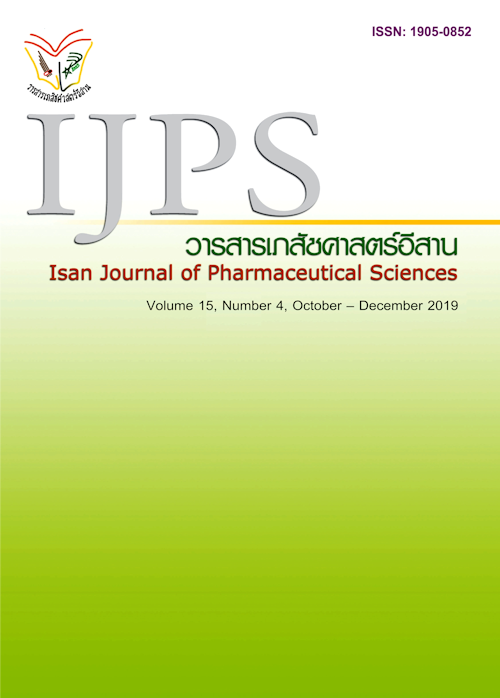Development of a screening tool for predicting the risk of leftover medicines in diabetic patients who take oral diabetic medications
Main Article Content
Abstract
Leftover medicines or oversupplies of prescribed medications associated with high cost and hospitalization risk. Especially in patients with chronic diseases such as diabetes. In the past, there has been a predicting leftover medication from logistic regression or decision tree techniques but not have screening tools for easy to use. Objective: To develop the screening questionnaires in diabetic patients who are at risk of having the leftover medicines by using Logistic Regression. Method: To find the factors effect on having the leftover medicines by interviewing and data collecting from patient’s database. Study on 800 diabetic patients who received the treatment at diabetic clinic in Sirindhorn Hospital and Sub-district Health Promoting Hospital in Sirindhorn district, Ubon Ratchathani Province from July - December 2016. Leftover medicines were collected from returned medicines, counting only oral diabetic medications. Using Logistic Regression to analyses factors that related to the leftover medicines and developed screening questionnaires from these factors. Results: From the sample, 179 patients (22.3 % of all samples) had the leftover medicines in accordance with this research definition (Medication possession ratio (MPR) > 1.2). By using Logistic Regression to analyse, found 3 statistical significance factors that related to the leftover medicines which were alcohol consumption history, merital status single, divorced or separated and pill count more than 5 pills per day increased the risk of having leftover medicines. The screening questionnaires in Diabetic Patients who are at risk of having the leftover medicines were developed from these factors. This questionnaires contain 0-8 score. Those who had more than 3 scores were at risk of having the leftover medicines. The sensitivity of this developed questionnaires is 49.72 percent. Specificity is 65.05 percent and receiver operating characteristic curve (Receiver Operating Characteristic (ROC) curve) is 60.4 (95% confidence interval (95%CI), 55.7-65.1). Conclusions: The developed screening questionnaires in Diabetic Patients who are at risk of having the leftover medicines was found the factor effect on having the leftover medicines It should be improve the screening questionnaires to be more accurate.
Article Details
In the case that some parts are used by others The author must Confirm that obtaining permission to use some of the original authors. And must attach evidence That the permission has been included
References
Chaiyakunapruk N, Nimpitakpong P, Dilokthomsakul P, et al. The size and fiscal impact of medication over possession, solving problem by policy. Phitsanulok: Center of Pharmaceutical Outcomes Research (CPOR) Faculty of Pharmaceutical Sciences Naresuan University; 2012.
Champunot P. Leftover medicines and medicine use behavior of people in Chiang Mai province [Master of Pharmacy (Pharmacy Manangement)]. Chiang Mai: Chiang Mai University; 2010.
Chen CC, Blank RH, Cheng SH. Medication supply, healthcare outcomes and healthcare expenses: Longitudinal analyses of patients with type 2 diabetes and hypertension. Health policy 2014; 117: 374-381.
Cheyoe N. Prevalence and Predictors of Insulin Non Adherence in T2D. HSRI 2016; 10(3): 333-339.
Ingkamanee N, Na Ayuthya S, Puwarawuttipanit W et al. Effectiveness of Promoting a Problem-Solving Ability Program on Medication Adherence in Patients with Type 2 Diabetic. J Nurs Sci 2011; 29(2): 56-64.
Jin J, Sklar GE, Oh VMS, et al. Factors affecting therapeutic compliance : A review from the patient’s perspective. Ther Clin Risk Manag 2008; 4: 269-286.
Kim H, Bowman JD, Cho NH. Comparing diabetic patient characteristics related to stated medication adherence in a rural vs. urban community in Korea. J Clin Pharm Ther 2015:1365-2710.
Klumrat K, Jongwutiwes K, Mahakan P, et al. Causal Factors of Health Behavior of Elderly in Western Region of Thailand. RMU.J.(Humanities and Social Sciences) 2013; 7(3): 93-103.
Marcum ZA, Zheng Y, Perera S, Strotmeyer E, et al. Prevalence and Correlates of Self-Reported Medication Non-Adherence among Older Adults with Coronary Heart Disease Diabetes Mellitus, and/or Hypertension. Res Social Adm Pharm 2013; 9(6): 817-827.
Office of The National Economic and Social Development Board. Health expenditure per Gross Domestic Product (GDP) 2002-2014 [Online]. 2015 Mar 17 [cited 2015 Jul 12]. Available from:https://social.nesdb.go.th
Office of the National Economics and Social Development Council. Health expanding in Thailand 1993-2018 [Online]. 2019 [cited 2019 May 12]. Available from: https://social.nesdb.go.th/SocialStat/StatReport_Final.aspx?reportid=1260&template=1R1C&yeartype=M&subcatid=18.
Petsom P. Health behaviors of Thai older persons [Master of Arts Program in Demography]. Bankok: Chulalonkorn University; 2015.
Swets JA. Measuring the accuracy of diagnostic systems. Science 1988; 240:1285-93.
Tavares NUL., Bertoldi AD, Thume E, et al. Factors associated with low adherence to medication in older adults. Revista de Saude Publica 2013; 47(6): 1092-1102.
Tayommai S, Chaiangpradit M, Kerdchantuk P. Statistical Modeling : The drug reconcile in diabetes patients with the applied logistic regression and decision tree [Master Degree of Science (Statistical Management Science)]. Mahasarakham: Mahasarakham University; 2015.
Thai Food and Drug Administration. Strategic plan of consumer protection in health products no.11 (2012-2016). Nonthaburi: Thai Food and Drug Administration; 2012.
Thai Rath online. Thailand burn 37 million tablets of drug from “Eggs in exchange for drugs” project. [Online]. 2012 [cited 2015 Jul 17]. Available from: https://www.thairath.co.th/content/275799
Thorpe C T et al. Medication oversupply in patients with diabetes. Res Social Adm Pharm 2015: 382-400.
Trueman P, Taylor D, Lowson K, et al. Evaluation of the scale, causes and costs of waste medicines. Report of DH funded national project. New York and London: Health Economics Consortium, The School of Pharmacy, University of London; 2010.


